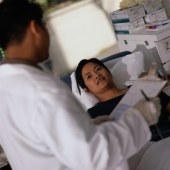
THURSDAY, Dec. 29 (HealthDay News) — If you’ve had a medical procedure lately, you probably first had blood tests, an imaging test like an MRI or ultrasound, perhaps an electrocardiogram and possibly more.
“Is all this really necessary?” you might have wondered.
That’s a question that doctors themselves are now raising as a growing body of evidence suggests that overuse of diagnostic testing may be harming patients’ health and driving up health-care costs.
“There is clear overuse or misuse of certain kinds of tests for certain patients,” said Dr. Steven E. Weinberger, executive vice president and chief executive officer of the American College of Physicians.
So should doctors exercise more restraint, or should patients take a more active and skeptical role in their care?
Weinberger believes the answer lies somewhere in the middle. “There needs to be an honest conversation in both directions, with a clear understanding about what is and isn’t necessary,” he said.
Experts agree that excessive testing is costing the U.S. health-care system billions through waste. Weinberger said that some estimates have suggested the cost could run as high as $200 billion to $250 billion a year, an amount equal to about 10 percent of the total amount spent on the nation’s health care.
But the true cost is borne by patients who face increased health risks associated with diagnostic testing, he said. Dr. Anthony Shih, executive vice president for programs of the Commonwealth Fund, a private health policy research foundation, agreed.
“Although most patients are aware that procedures carry some risks, they are less aware that tests carry risks,” Shih said.
Diagnostic testing, in fact, carries three main risks, Weinberger and Shih said:
- Risks directly related to the test itself, such as the radiation exposure caused by imaging tests.
- The risk for a false positive, which can lead to a string of other unnecessary follow-up tests and procedures, each with their own sets of potential health hazards.
- The risk that a condition will be identified that never would have been clinically significant but now will probably be treated.
A routine electrocardiogram, for example, might identify some nonspecific condition that leads to a cardiac catheterization, an invasive medical procedure that carries its own set of health risks, Weinberger said.
“Unnecessary testing is not necessarily benign,” he said. “It can lead to situations that can pose health risks to patients.”
Clearly, patients should become more active in asking whether tests are necessary. But as most anyone who’s been a patient can attest, asking such questions can be daunting for anyone, but especially for a sick person who needs treatment.
Weinberger said he has personal experience when it comes to the difficulty of challenging tests as a patient. He recently had arthroscopic surgery for a knee injury, but before the procedure he had to undergo a battery of diagnostics that included lab tests, a chest X-ray and an electrocardiogram — all unnecessary, as far as he could tell. And yet, he had the tests without questioning them.
“My experience shows you how hard it is,” Weinberger said. “If there’s anyone who was in a position to question these tests, it’s someone like me.” But, he admitted, “you don’t want to antagonize the person who’s going to provide your care. Sometimes the easiest road is to just go along.”
His organization, the American College of Physicians, has started tackling the issue through what it calls its High-Value, Cost-Conscious Care Initiative, which aims to reduce unnecessary testing by educating physicians and patients alike on the benefits, harms and costs of tests linked to specific ailments.
“We’re basically trying to develop a list of those types of things that are overused and explore the evidence behind why they are overused,” Weinberger said.
Shih said that people who are facing diagnostic tests should use such resources to educate themselves and then feel free to question their doctor about the tests that have been ordered.
“The patient should always ask what the test is looking for, what the potential harms are for the test, and what the next steps are if the test finds something,” he said. “As the tests get more invasive and more complex, I would be more careful about asking for the reasoning behind each test.”
Ultimately, however, both patients and doctors need to keep in mind that the necessity of tests is a very specific and personal matter, Shih added.
“It’s important to recognize that for any given patient, even with the exact same condition, the decision may not be the same,” he said. “It depends on the values and preferences of each patient.”
“Some patients want to be absolutely sure, while other patients may be more comfortable with uncertainty,” Shih explained. “There is no hard-and-fast rule for which tests might be appropriate for each situation.”
More information
The U.S. Agency for Healthcare Research and Quality has more on communicating with your doctor.

